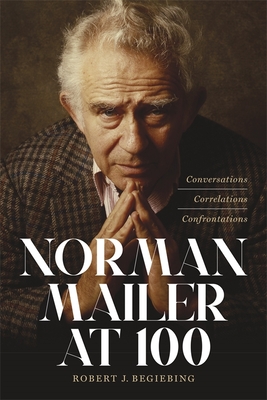Written by Fran Skennion Reilly
 Norman Mailer at 100: Conversations, Correlations, Confrontations (Louisiana State University Press, November 2022) by Robert J. Beigiebing is a collection of essays, dramatic dialogues, and interviews – both imagined and real – published to commemorate Mailer’s centenary and the 75th anniversary of his debut novel, The Naked and The Dead. Reading this collection brought me back to my late teens and early twenties when I read whatever I could by Mailer. I remember being transported by Executioner’s Song, and eagerly awaiting the arrival of Ancient Evenings. An aspiring writer then, I wanted to write like him. It’s not surprising then that what resonated for me most in this collection were the insights into his craft. There are many of them to be found.
Norman Mailer at 100: Conversations, Correlations, Confrontations (Louisiana State University Press, November 2022) by Robert J. Beigiebing is a collection of essays, dramatic dialogues, and interviews – both imagined and real – published to commemorate Mailer’s centenary and the 75th anniversary of his debut novel, The Naked and The Dead. Reading this collection brought me back to my late teens and early twenties when I read whatever I could by Mailer. I remember being transported by Executioner’s Song, and eagerly awaiting the arrival of Ancient Evenings. An aspiring writer then, I wanted to write like him. It’s not surprising then that what resonated for me most in this collection were the insights into his craft. There are many of them to be found.
In the opening section, Beigiebing tells us that Mailer was continually revising his work and his ideas, that he was “on a journey,” each book “a stop along the way.” There’s a parallel track between that observation and the structure of this book: each chapter illumines a different facet of Mailer’s work, one reflected through the prism of writers and thinkers he was connected to as a fellow traveler in life or spirit. Hemingway, Didion, Millett, Emerson, Whitman. Covering topics from cannabis to corporate capitalism, democracy to demons, miles of thought-provoking issues are covered. Beigebing writes with an academic quality that requires some intention on the reader’s part, but for writers, aspiring writers, fans or students of Mailer, it’s worth the ride.
Chapters featuring Hemingway bookend the collection. The first one delves into comparisons of the two men, noting that they both launched their careers with big war novels. It’s well known that Mailer based his 1948 war novel, The Naked and the Dead, on his experience serving in the Pacific theater during World War II. He used letters home as a formative technique for the novel he planned to write, sending letters to his wife that documented the landscape, soldiers, and combat. Writing these letters helped him to work through his ideas. Another craft-element souvenir I took from that chapter is Mailer’s thought that good writers are committed to “fully engaged lives that inspire their work” – they don’t make their lives smaller in service to the writing.
Writing letters reappears in a fascinating chapter in Mailer’s soon to be published, “Lipton’s Journal” –this time Mailer is writing letters to himself during an intense three-month period of self-refection in 1954-55 aided by cannabis and the teachings of Carl Jung. Mailer used “tea” to “tap the unconscious” and engage with the “deep collective truths of the soul.” Later in a chapter on Emerson, Beigebing observes that both Mailer and Emerson used journaling as “an approach to the deeper psychic territory of the soul…a way to reveal and to discover oneself.” This “unconscious feeding of the creative process” underscores another insight into Mailer’s craft—he didn’t write outlines. “My best scenes are the ones I didn’t know what I was doing,” he once wrote. During this time tea-time period Mailer also developed an appreciation for jazz, calling it one of the “the most important pathways to artistic renewal.” Soul-bearing journal writing and riffing in jazz both require risk-taking; you go on “whether you succeed or fail.”
The theme of risk-taking is picked up again in the chapter on Joan Didion. They shared an “ethic of risk taking” as writers and respected each other for it. Mailer admired Didion’s “power of montage”—the way she built empty spaces between vivid, clustered details. Didion quoted Mailer in an essay she wrote about Hemingway: “All writing is generated by a certain amount of ego…” Beigebing juxtaposes Mailer and Didion on the notion of ego, and of fear. I found some level of solace in being reminded that even writers of their stature also face fear when staring at the blank page. Mailer said it was always present: “Writing a book is the fear… It’s obvious that you can’t be a professional writer for as many years as I have without taking a certain pride that can endure those fears.”
Inventive, entertaining dramatic dialogues and interviews enrich the pace of the book. For instance, his chapter on Mailer and Whitman, an imagined “Interview on Democracy in America,” begins with stage direction: “Entering from stage right, Mailer sees a wicker armchair.” In fast, colorful dialogue so real we can almost hear Whitman warn Mailer that “rant does not satisfy the soul,” and “…for as long as the spirit has not changed, any change of appearance is of no avail.” We can almost picture Mailer jump up from his chair, arms raised, when he shouts ”a revolution of consciousness!”
The ending chapter of Norman Mailer at 100 is a masterful dramatic dialogue between Mailer and Hemingway that seems utterly prescient for his 100th birthday. The scene is set in limbo, opening in purgatory on the shore of a river where Mailer is stopping before his final, eternal journey. Hemingway greets him there: “Follow me…I’ll lead you to the eternal place, so long the object of your speculations. And to your rest. This way.”
 Fran Skennion Reilly is nonfiction writer and media professional with extensive experience in the national magazine and newspaper industries. A published writer of essays and poems, she is currently working on her first memoir. She earned a master of fine arts from the Maslow Family Graduate Program in Creative Writing at Wilkes University.
Fran Skennion Reilly is nonfiction writer and media professional with extensive experience in the national magazine and newspaper industries. A published writer of essays and poems, she is currently working on her first memoir. She earned a master of fine arts from the Maslow Family Graduate Program in Creative Writing at Wilkes University.


